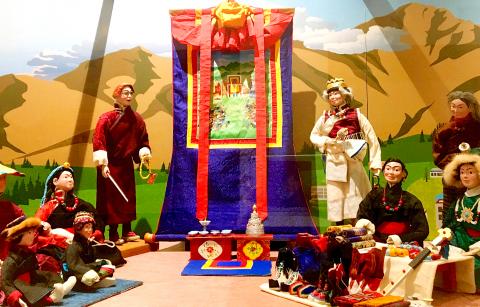Opening tomorrow, Tibet at a Glance: Special Exhibition of Tibetan Miniatures at the Mongolian and Tibetan Cultural Center showcases Tibetan figurines made by monks at the Drepung Loseling Monastery in India.
Decked out in traditional clothes, the figurines are an introduction to the profound and diverse culture of Tibet. The exhibition will cover seven themes: kings and ministers; Lhasa street scenery; Tibetan costume; vajra or tantric dance; prayer; Milarepa, a celebrated historical figure in Tibetan Buddhism; and Tibetan theater.
Drepung Loseling Monastery itself has a fascinating history. Established in 1416, the original Drepung Monastery was regarded as the most important monastery of the Gelug school of Tibetan Buddhism. Located at the foot of Mount Gephel on the outskirts of Lhasa, in its heyday, the monastery housed 7,700 monks and was thought to be the largest in the world.

Photo courtesy of Ministry of Culture
After the Tibetan uprising in 1959 and China’s ensuing crackdown on Tibetan governance, religious and social structures, about 250 monks from Drepung Monastery escaped to India, where they founded Drepung Loseling Monastery in the spirit of the original. This “monastery in exile” now houses more than 3,000 monks.
Tibet at a Glance is part of the ongoing Tibetan Culture and Art Festival, organized by the Ministry of Culture and now in its fifth year.
The festival program also includes four talks conducted in Mandarin on Tibetan life, death and wedding rites; Tibetan documentaries; spirituality; and Tibetan yoga. The talks will take place tomorrow and on Jan. 18, Feb. 22 and March 14 next year respectively. In addition, there will be interactive sessions to make hand-molded rice flour figurines and paper crafts on Dec. 28 this year and March 21 next year respectively.

Photo courtesy of Ministry of Culture
■ Tibet at a Glance: Special Exhibition of Tibetan Miniatures shows until March 31 next year and is open Mondays to Saturdays, 9am to 6pm at the Mongolian and Tibetan Cultural Gallery (蒙藏文化館), 3, Lane 8, Qingtian St, Taipei City (臺北市青田街八巷三號).
■ Online registration is required for the talks and hands-on activities at: event.culture.tw/MOC. Several events are already booked.

In the March 9 edition of the Taipei Times a piece by Ninon Godefroy ran with the headine “The quiet, gentle rhythm of Taiwan.” It started with the line “Taiwan is a small, humble place. There is no Eiffel Tower, no pyramids — no singular attraction that draws the world’s attention.” I laughed out loud at that. This was out of no disrespect for the author or the piece, which made some interesting analogies and good points about how both Din Tai Fung’s and Taiwan Semiconductor Manufacturing Co’s (TSMC, 台積電) meticulous attention to detail and quality are not quite up to

April 21 to April 27 Hsieh Er’s (謝娥) political fortunes were rising fast after she got out of jail and joined the Chinese Nationalist Party (KMT) in December 1945. Not only did she hold key positions in various committees, she was elected the only woman on the Taipei City Council and headed to Nanjing in 1946 as the sole Taiwanese female representative to the National Constituent Assembly. With the support of first lady Soong May-ling (宋美齡), she started the Taipei Women’s Association and Taiwan Provincial Women’s Association, where she

Chinese Nationalist Party (KMT) Chairman Eric Chu (朱立倫) hatched a bold plan to charge forward and seize the initiative when he held a protest in front of the Taipei City Prosecutors’ Office. Though risky, because illegal, its success would help tackle at least six problems facing both himself and the KMT. What he did not see coming was Taipei Mayor Chiang Wan-an (將萬安) tripping him up out of the gate. In spite of Chu being the most consequential and successful KMT chairman since the early 2010s — arguably saving the party from financial ruin and restoring its electoral viability —

It is one of the more remarkable facts of Taiwan history that it was never occupied or claimed by any of the numerous kingdoms of southern China — Han or otherwise — that lay just across the water from it. None of their brilliant ministers ever discovered that Taiwan was a “core interest” of the state whose annexation was “inevitable.” As Paul Kua notes in an excellent monograph laying out how the Portuguese gave Taiwan the name “Formosa,” the first Europeans to express an interest in occupying Taiwan were the Spanish. Tonio Andrade in his seminal work, How Taiwan Became Chinese,